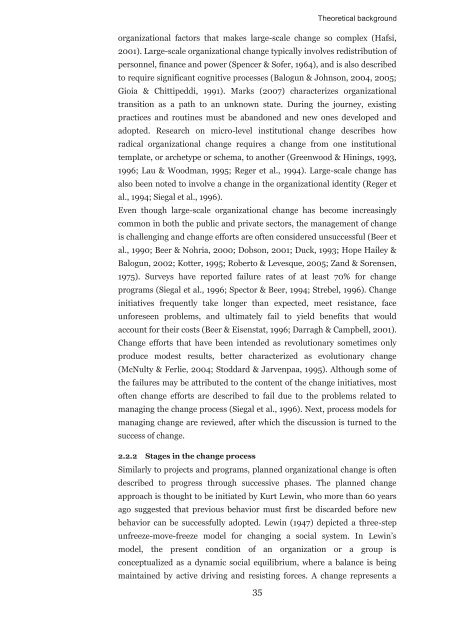Boundary activities and readiness for ... - Projekti-Instituutti
Boundary activities and readiness for ... - Projekti-Instituutti
Boundary activities and readiness for ... - Projekti-Instituutti
Create successful ePaper yourself
Turn your PDF publications into a flip-book with our unique Google optimized e-Paper software.
Theoretical background<br />
organizational factors that makes large-scale change so complex (Hafsi,<br />
2001). Large-scale organizational change typically involves redistribution of<br />
personnel, finance <strong>and</strong> power (Spencer & Sofer, 1964), <strong>and</strong> is also described<br />
to require significant cognitive processes (Balogun & Johnson, 2004, 2005;<br />
Gioia & Chittipeddi, 1991). Marks (2007) characterizes organizational<br />
transition as a path to an unknown state. During the journey, existing<br />
practices <strong>and</strong> routines must be ab<strong>and</strong>oned <strong>and</strong> new ones developed <strong>and</strong><br />
adopted. Research on micro-level institutional change describes how<br />
radical organizational change requires a change from one institutional<br />
template, or archetype or schema, to another (Greenwood & Hinings, 1993,<br />
1996; Lau & Woodman, 1995; Reger et al., 1994). Large-scale change has<br />
also been noted to involve a change in the organizational identity (Reger et<br />
al., 1994; Siegal et al., 1996).<br />
Even though large-scale organizational change has become increasingly<br />
common in both the public <strong>and</strong> private sectors, the management of change<br />
is challenging <strong>and</strong> change ef<strong>for</strong>ts are often considered unsuccessful (Beer et<br />
al., 1990; Beer & Nohria, 2000; Dobson, 2001; Duck, 1993; Hope Hailey &<br />
Balogun, 2002; Kotter, 1995; Roberto & Levesque, 2005; Z<strong>and</strong> & Sorensen,<br />
1975). Surveys have reported failure rates of at least 70% <strong>for</strong> change<br />
programs (Siegal et al., 1996; Spector & Beer, 1994; Strebel, 1996). Change<br />
initiatives frequently take longer than expected, meet resistance, face<br />
un<strong>for</strong>eseen problems, <strong>and</strong> ultimately fail to yield benefits that would<br />
account <strong>for</strong> their costs (Beer & Eisenstat, 1996; Darragh & Campbell, 2001).<br />
Change ef<strong>for</strong>ts that have been intended as revolutionary sometimes only<br />
produce modest results, better characterized as evolutionary change<br />
(McNulty & Ferlie, 2004; Stoddard & Jarvenpaa, 1995). Although some of<br />
the failures may be attributed to the content of the change initiatives, most<br />
often change ef<strong>for</strong>ts are described to fail due to the problems related to<br />
managing the change process (Siegal et al., 1996). Next, process models <strong>for</strong><br />
managing change are reviewed, after which the discussion is turned to the<br />
success of change.<br />
2.2.2 Stages in the change process<br />
Similarly to projects <strong>and</strong> programs, planned organizational change is often<br />
described to progress through successive phases. The planned change<br />
approach is thought to be initiated by Kurt Lewin, who more than 60 years<br />
ago suggested that previous behavior must first be discarded be<strong>for</strong>e new<br />
behavior can be successfully adopted. Lewin (1947) depicted a three-step<br />
unfreeze-move-freeze model <strong>for</strong> changing a social system. In Lewin’s<br />
model, the present condition of an organization or a group is<br />
conceptualized as a dynamic social equilibrium, where a balance is being<br />
maintained by active driving <strong>and</strong> resisting <strong>for</strong>ces. A change represents a<br />
35









